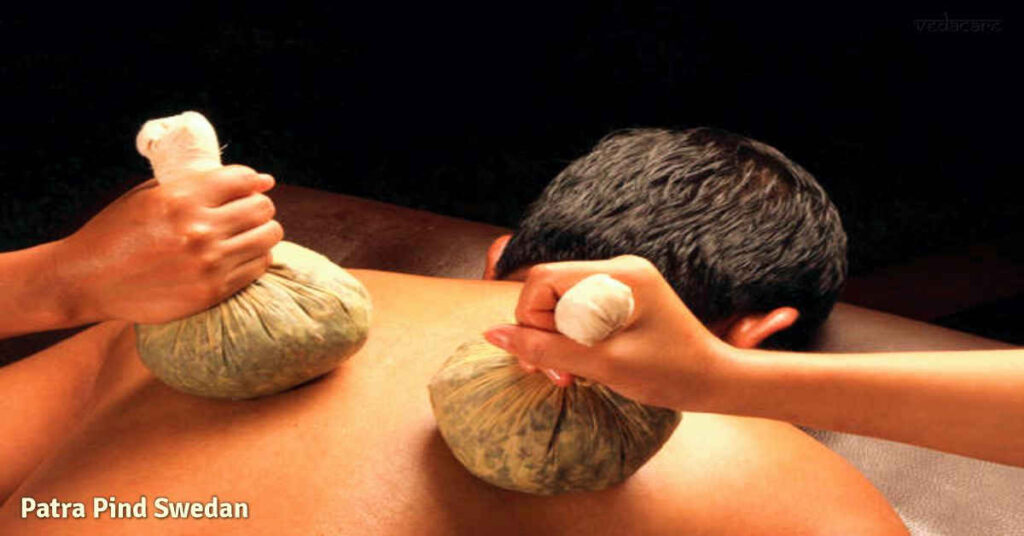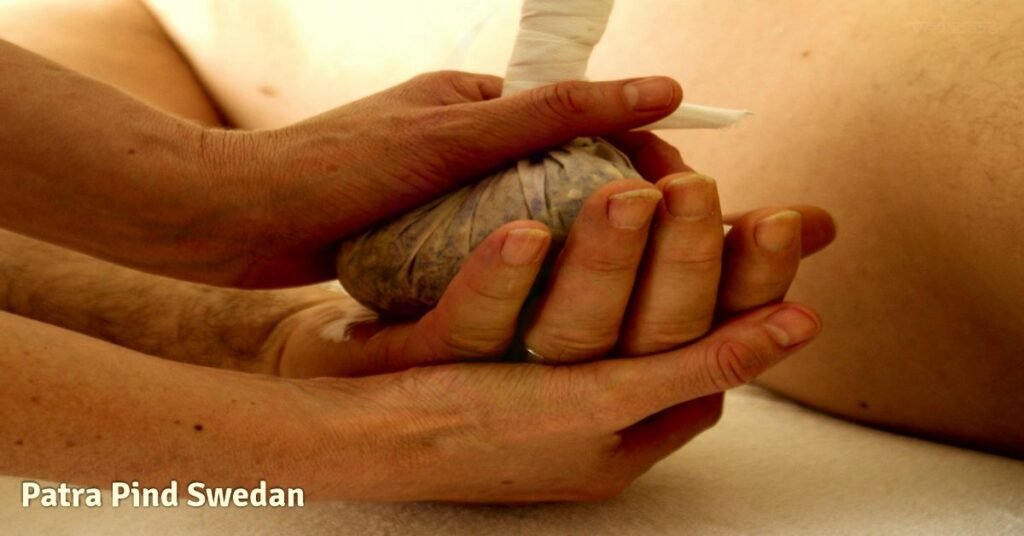PANCHAKARMA
Patra Pinda Sweda (Patra Pottali Sweda) पत्र पोट्टली स्वेद – Ayurvedic Herbal Fomentation Therapy for Pain Relief

Patra Pinda Sweda, also known as Patra Pottali Sweda, is one of the most effective and widely practiced forms of Swedana (Ayurvedic sudation therapy). It involves the application of warm herbal leaf boluses (pottali) to relieve pain, reduce inflammation, and improve mobility in joints and muscles. This therapy is especially effective in treating Vata and Kapha dosha imbalances.
What is Patra Pinda Sweda?
In this therapy, specific medicated leaves are selected based on the condition and are heated with medicated oils. These are then tied in cotton cloth to form boluses and applied warm over affected areas. The heat and medicinal properties of the herbs penetrate deep into the tissues, improving circulation, reducing stiffness, and detoxifying the body.
Whether you’re seeking relief from arthritis, joint pain, or muscle strain, Patra Pottali Sweda offers a natural, holistic approach to wellness.
Patra Pinda Sweda Procedure:
Preparation of Herbal Boluses:
- Selection of Herbal Leaves: Fresh leaves with anti-inflammatory and pain-relieving properties, such as Nirgundi (Vitex negundo) or Eranda (Ricinus communis), are chosen based on the patient’s condition.
- Chopping and Frying: The leaves are cut into small pieces and fried in a round-bottom vessel with medicated oil (e.g., Mahanarayan or Dhanwantaram oil). Continuous stirring ensures even frying and prevents burning.
- Forming Pinda: The fried leaves are tied into small bundles (pinda) using cotton cloth, creating compact packs for application.
- Heating the Pinda: The bundles are dipped in warm medicated oil and moved continuously to maintain an optimal temperature for therapy.
- Positioning: The treatment can be performed with the patient in a sitting or lying position, depending on the targeted area.
No specific pre-treatment preparation is required, making it a convenient therapy that can be administered at any time of day based on the patient’s needs.
Application:
- The patient is positioned either sitting or lying down, based on the affected area.
- The warm boluses are applied with gentle pressure and circular motion.
- The therapist ensures the temperature is consistent by reheating the pottali in medicated oil.
- Therapy continues for 30 to 45 minutes.
After the therapy, proper post-treatment care is essential to maximize its benefits and prevent discomfort. Here’s what to expect:
Post-Therapy Care:
- Rest Period: Patients are advised to rest in a chair for about 15 minutes to allow the body to stabilize after the intense sudation process.
- Hot Water Bath: A warm bath is recommended to refresh the body and alleviate any residual tiredness. Avoid using harsh soaps; instead, use Ayurvedic ubtan (herbal powder) or Bengal gram flour to gently cleanse the skin and remove excess oil.
- Dietary Guidelines: Consume light, warm, and liquid-based foods, such as khichdi or vegetable soup, to support digestion and recovery. Avoid heavy, cold, or processed foods.
- Environmental Precautions: Stay in a room at normal temperature without fans or air conditioning for a short period. Avoid exposure to cold breezes, open air, or cold water immediately after the therapy.
Duration and Frequency of Patra Pottali Sweda:
The duration and frequency of Patra Pottali Sweda depend on the individual’s health condition and therapeutic goals:
Therapeutic Use: For individuals with chronic conditions like arthritis or spondylitis, more frequent courses may be necessary, tailored to the severity of the condition and the patient’s response to treatment.
Standard Course: A typical course involves 7, 14, or 21 sessions, conducted daily or on alternate days. A 14-day course is ideal for promoting general health in healthy individuals.
Maintenance: One to two courses per year are recommended for preventive care and overall wellness.
- Patient should rest for 15 minutes post-treatment.
- Use Ayurvedic ubtan or besan (gram flour) for cleansing oil.
- Avoid cold exposure, air conditioning, and immediate bathing with cold water.
- Prefer lukewarm water bath 1–2 hours after therapy.
- Light, warm, easy-to-digest meals should be consumed.
Benefits of Patra Pinda Sweda:
- Alleviates joint pain and inflammation
- Effective for osteoarthritis, rheumatoid arthritis, sciatica
- Improves joint mobility and flexibility
- Reduces muscle stiffness and cramps
- Enhances blood circulation and lymphatic drainage
- Promotes tissue regeneration
- Aids in treating neuromuscular and degenerative disorders
Whether you’re searching for a natural remedy for arthritis, Ayurvedic treatment for back pain, or a non-invasive therapy for joint stiffness, Patra Pinda Sweda is an excellent option rooted in centuries of holistic healing.

Patra Pinda Sweda Indications:
- Vata Vyadhi (neuromuscular disorders)
- Arthritis (osteoarthritis, rheumatoid)
- Sciatica
- Spondylosis (cervical and lumbar)
- Muscle spasms and injuries
- Gout
- Paralysis
- Joint stiffness and back pain
- Varicose veins
- Tendonitis
Contraindications:
- Fever or acute inflammation
- Open wounds or infections
- During menstruation or pregnancy (unless advised)
- Skin allergies to herbs or oil
1. What are the key herbs used in Patra Pinda Sweda?
Commonly used herbs include Eranda (castor leaves), Nirgundi, Shigru (drumstick), and Arka. These herbs have anti-inflammatory and analgesic properties.
2. Is Patra Pinda Sweda safe for elderly people?
Yes, when performed under trained Ayurvedic supervision, it is safe and highly beneficial for seniors suffering from arthritis or back pain.
3. How many sessions are required for chronic pain relief?
For chronic issues, a minimum of 14 sessions is usually recommended. However, the final course depends on individual assessment
4. Can Patra Pinda Sweda be combined with other Panchakarma treatments?
Yes, it is often combined with Abhyanga (Ayurvedic massage) and Basti (medicated enema) for holistic pain management.
5. Can it help avoid joint replacement surgery?
Many patients with early-stage arthritis or degenerative joint conditions report significant relief and improvement, thereby delaying or avoiding surgery
6. What is the recovery time after the treatment?
There is no downtime. Patients can resume normal activities but should avoid strenuous tasks and cold exposure on the treatment day.
7. Can diabetics undergo this therapy?
Yes!
8. Post-treatment restrictions?
Avoid cold exposure, AC, and heavy meals for 6 hours post-therapy.
9. Does Patra Pinda Sweda help slipped disc?
Yes!
Along with patra svedan therapy Basti Panchakarma, Raktamokshan, Agnikarma, Patra Pinda Sweda, Lepan treatments are useful in fastening the disease recovery or relieving chronic pain.



